Emperor Hadrian ordered a mighty wall to be built in AD 122, to guard the wild north-west frontier of the Roman Empire. But it was more than just a barrier. Hadrian's Wall was also a home for soldiers, traders, craftspeople and families from Britain, Europe and North Africa.
The Romans must have done a good job building the wall, because nearly 2000 years later, sections of it are still standing today. Take a closer look at Hadrian's Wall with these 7 features…
1 Towns
Alongside the big forts like Chesters, civilian towns called vici appeared. Roman soldiers had a lot more money to spend than local people, so civilians built shops in the towns to sell goods to the troops.
2 Milecastles
These were small forts built every mile along the wall. Milecastles had gates so that people could pass from one side of the wall to the other, if they were brave enough! You can still see remains of these at Poltross Burn (pictured) and Cawfields.
3 Turrets
There were two turrets in between each milecastle. They provided shelter and a place to warm up for a couple of Roman soldiers. Turrets like the ones at Birdoswald (pictured) could have been the loneliest places to be on Hadrian’s Wall.
4 The Wall Itself
The wall that you see today is only a small fraction of the original. Over the centuries since it was built, stone has been removed, buried or destroyed. In between the forts and turrets, the wall would have been an impressive barrier, standing 4–4.5 metres high with a ditch in front.
5 Bridges
The wall stretched across the north of England from one coast to the other over the land, but what about rivers? Patrols and supplies needed to get across. Luckily the Romans were expert architects and managed to build bridges like Chesters Bridge over rivers to keep the Wall as one solid, unbroken barrier.
6 Forts
Large forts like Chesters and Housesteads were built after construction of the wall started, to house big garrisons of men to patrol the wall and be called upon in case of an attack. All of the forts, milecastles and turrets were linked by a military road.
7 Vallum
As well as keeping eyes focused on enemies to the north of the wall, the Romans also needed to make sure they were safe from the south. The vallum was an earth mound and ditch behind the wall that marked an area that local Britons weren’t allowed into. Stone bridges like the one at Benwell were built to cross over the vallum.
Hail, HADRIAN! Meet the emperor behind the wall
When Emperor Hadrian came to Britain in AD122 and saw how much trouble his soldiers were having in the north, he ordered his men to build a huge wall to defend themselves and the lands they’d spent so long taking in Britain. Hadrian’s Wall took around 15,000 men about six years to build. The emperor never returned to Britain and so never got to see his soldiers’ achievement in all its glory.





